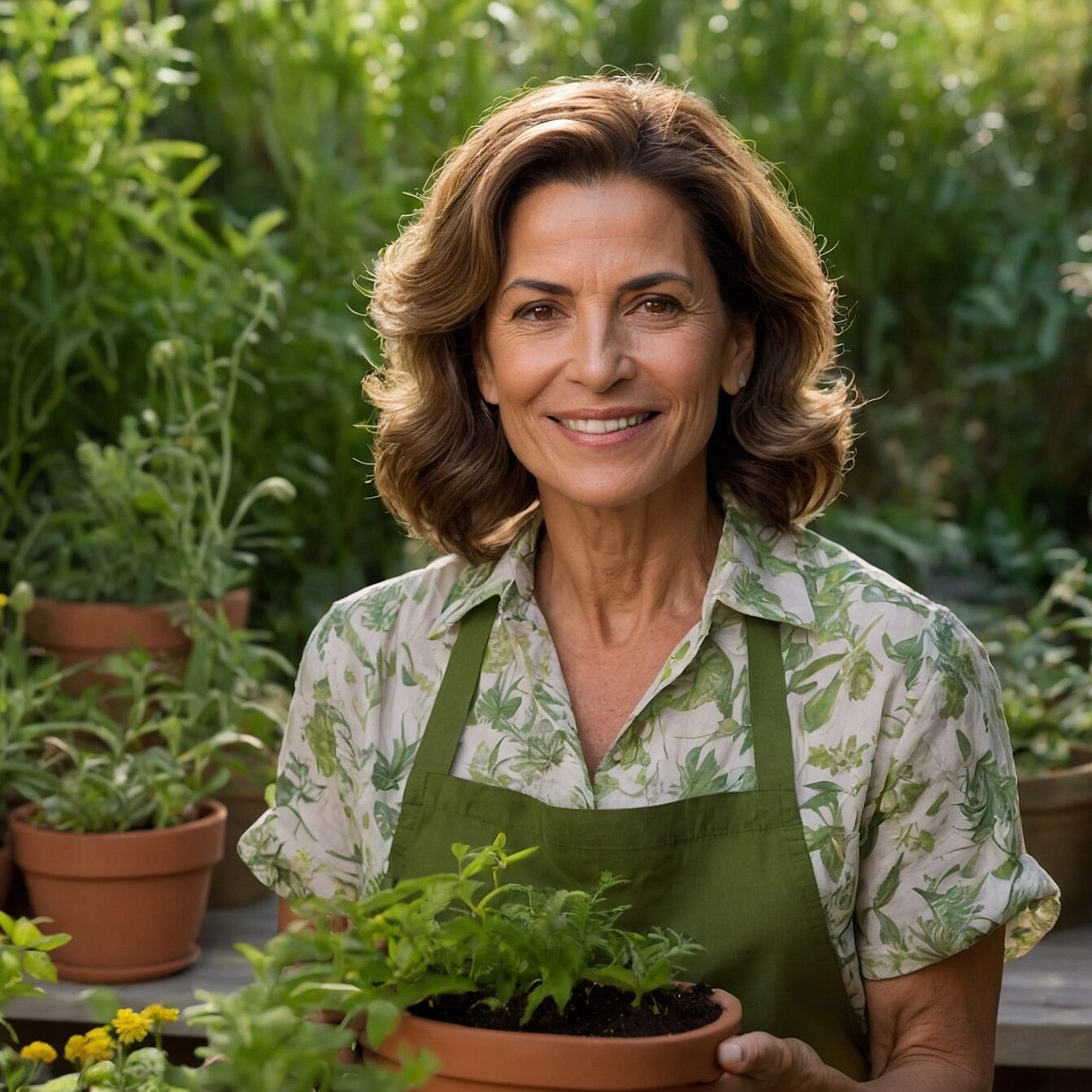Table of Contents
Introduction
Having a pergola in your garden or backyard is an excellent way to create an outdoor space that is both functional and aesthetically pleasing. However, to maximize the potential of this space, it is essential to choose the right plants to cover it. Climbing plants not only beautify the pergola, but also provide natural shade, creating a cooler and more comfortable environment during the warmer months.
Covering a pergola with plants has several benefits. Firstly, aesthetically, plants add a natural and organic beauty to the space, making it more welcoming and inviting. The varied flowers and foliage can complement the garden decor, adding different colors and textures.
In addition, the natural shade created by climbing plants helps to reduce the temperature under the pergola, making it a perfect place to relax or receive guests, even on the hottest days. The plants also act as a natural barrier against the wind and, in some situations, can help to muffle sound, creating a quieter environment.
Finally, the plants that cover the pergola contribute significantly to improving the environment. They help purify the air, increase biodiversity by attracting beneficial birds and insects, and can even provide edible fruit or flowers, depending on the species chosen.
Content Overview
In this post, we will explore five ideal plants for covering pergolas. Each plant will be detailed with its characteristics, growing conditions and specific benefits. The plants selected are:
- Jasmine (Jasminum spp.)
- Bougainvillea (Bougainvillea spp.)
- English Ivy (Hedera helix)
- Purple Passionflower (Passiflora spp.)
- Honeysuckle (Lonicera spp.)
Let’s dive into the details of each of these plants to help you choose the best option for your pergola, ensuring that it becomes a charming and functional focal point in your outdoor space.
1. Jasmine (Jasminum spp.)
Description and Characteristics
Jasmine(Jasminum spp.) is a popular climbing plant known for its fragrant and delicate flowers. There are several species of Jasmine, such as Poet’s Jasmine (Jasminum polyanthum) and Star Jasmine (Trachelospermum jasminoides), each with its own unique characteristics. Jasmine flowers range from white to yellow and are highly fragrant, making them a charming choice for any garden. Jasmine’s foliage is usually dark green and glossy, providing beautiful cover throughout the year.
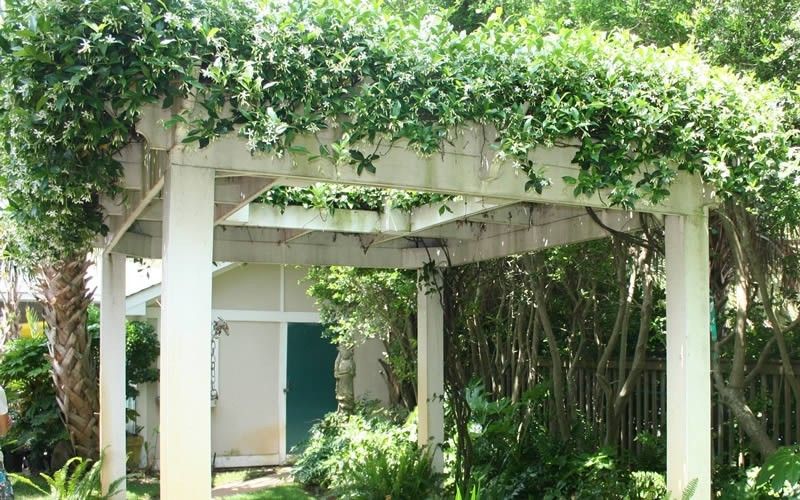
Growing conditions
Jasmine thrives in full to partial sunlight, preferring well-drained soil rich in organic matter. It is a relatively hardy plant, tolerating a variety of climates, but it thrives best in regions with mild winters and hot summers. Regular watering is necessary to keep the soil moist, especially during dry periods. To promote vigorous and healthy growth, it is recommended to fertilize the plant in spring and summer.
Benefits for the Pergola
Covering a pergola with Jasmine brings numerous benefits. First of all, the pleasant scent of the flowers creates a welcoming and relaxing atmosphere, ideal for moments of leisure and socializing. The showy flowers add a touch of elegance and color, making the pergola an attractive focal point in the garden. What’s more, Jasmine is able to cover quickly, forming a dense layer of foliage that provides natural shade and protection from the sun. This plant not only beautifies the pergola, but also contributes to a cooler and more comfortable environment.
2. Bougainvillea (Bougainvillea spp.)
Description and characteristics
The Bougainvillea (Bougainvillea spp.) is a climbing plant known for its vibrant colors and exuberant growth. There are several varieties of Bougainvillea, featuring a wide range of colors, including pink, purple, red, orange, white and yellow. Bougainvillea flowers are actually colorful bracts that surround the true flowers, which are small and inconspicuous. This plant is famous for its vigorous growth and can cover large areas quickly. However, due to its rapid growth, Bougainvillea requires regular pruning to maintain its shape and control its size.
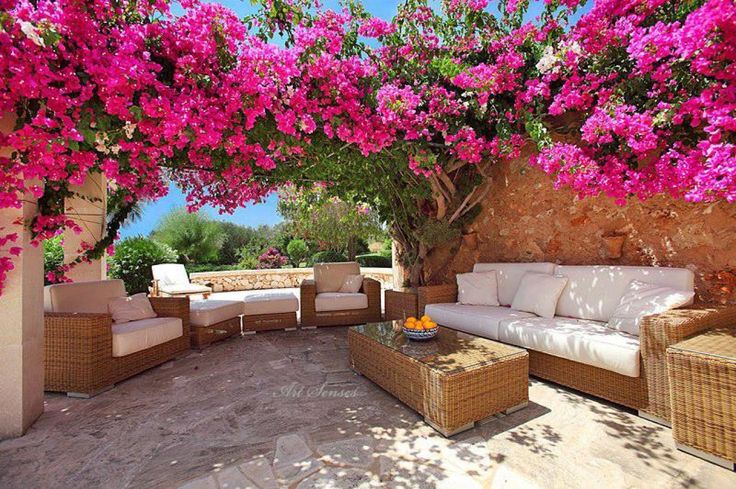
Growing conditions
Bougainvillea thrives in full sunlight, needing at least 6 hours of direct sunlight a day to flower profusely. It prefers well-drained, slightly acidic soil and is quite drought-tolerant once established. This plant is suitable for hot, dry climates, but can be grown in colder climates if protected from frost. During the initial growth phase, it is important to water regularly, but once established, Bougainvillea is quite drought-resistant, requiring less water.
Benefits for the Pergola
Bougainvillea is an excellent choice for covering pergolas due to its vibrant flowers, which add a burst of color and life to any space. This plant has a long flowering season, often blooming for most of the year in warm climates, which provides a spectacular look for long periods. In addition, Bougainvillea is known for its resilience, being able to withstand adverse conditions such as drought and poor soil, making it a low-maintenance plant. Its vigorous growth and ability to quickly cover large areas make it an ideal choice for those who want to transform their pergola into a colorful and exuberant refuge.
3. English Ivy (Hedera helix)
Description and characteristics
English Ivy (Hedera helix) is an evergreen climbing plant known for its dense and versatile foliage. There are several types of English Ivy, such as English Ivy (Hedera helix) and variegated English Ivy, which has leaves with white or yellow edges. English Ivy grows quickly and is able to cover large areas, adhering to surfaces with its aerial roots. English Ivy’s foliage is evergreen, which means it stays green all year round, providing continuous cover and color.
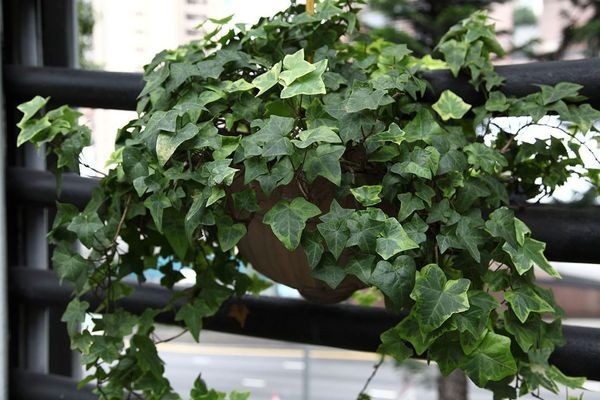
Growing conditions
English Ivy is extremely shade-tolerant, which makes it ideal for areas where other plants may struggle to grow. It can grow in a variety of soil types, as long as they are well-drained. English Ivy also tolerates a wide range of humidity, although it prefers slightly damp soils. This plant is quite hardy and can grow in adverse conditions, including polluted areas and areas with little direct sunlight. It is important to monitor its growth, as English Ivy can become invasive if left unchecked.
Benefits for the Pergola
Covering a pergola with English Ivy offers several benefits. English Ivy provides a dense cover, which not only offers natural shade, but also creates a more private and welcoming environment. One of the main advantages of English Ivy is its low maintenance. Once established, it requires little intervention, apart from occasional pruning to control its growth. English Ivy is also highly adaptable to various conditions, including shade and less fertile soils, making it a practical and reliable choice for pergolas. Its evergreen foliage guarantees a green and vibrant pergola all year round, regardless of the season.
4. Purple Passionflower (Passiflora spp.)
Description and Characteristics
The Purple Passionflower (Passiflora spp.) is a climbing plant known for its exotic flowers and its ability to produce delicious fruit. Passionflowers are highly ornamental, with intricate structures and vibrant colors that can range from white to purple and blue. In addition to its beauty, the Purple Passionflower is famous for producing edible fruits, known for their sweet and sour taste. This plant has a vigorous, climbing growth and is able to quickly cover structures such as pergolas.
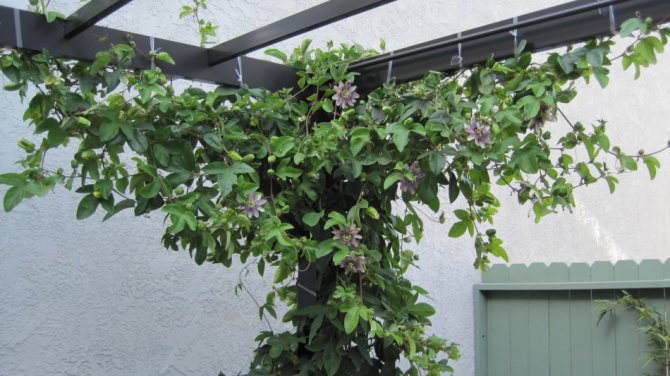
Growing conditions
Purple Passionflower needs full sunlight to flower and fruit optimally, requiring at least 6 hours of direct sunlight a day. It prefers well-drained soil rich in organic matter, which provides the necessary nutrients for rapid growth. Watering should be regular, especially during periods of drought, to keep the soil moist but not soggy. In regions with cold winters, it is advisable to protect the plant from frost.
Benefits for the pergola
Covering a pergola with Purple Passionflower offers several benefits. Firstly, the beauty of the exotic flowers adds a unique, tropical touch to the space, making it a focal point in the garden. The production of edible fruit is another great benefit, allowing you to pick fresh passion fruit directly from the pergola for consumption or culinary use. In addition, Passiflora flowers attract pollinators such as bees and butterflies, contributing to the biodiversity and overall health of the garden. With its rapid and vigorous growth, the Purple Passionflower not only beautifies the pergola, but also provides natural shade and a pleasant environment in which to relax and enjoy nature.
5. Honeysuckle (Lonicera spp.)
Description and Characteristics
Honeysuckle (Lonicera spp.) is a climbing plant prized for its fragrant flowers and dense foliage. There are several popular varieties, including the Japanese Honeysuckle (Lonicera japonica) and the Trumpet Honeysuckle (Lonicera sempervirens), each with its own unique characteristics. Honeysuckle flowers are usually tubular and can vary in color from white to yellow and red, exuding a strong, sweet scent that is especially pronounced at dusk. Honeysuckle’s foliage is thick, providing a lush, green canopy for most of the year.
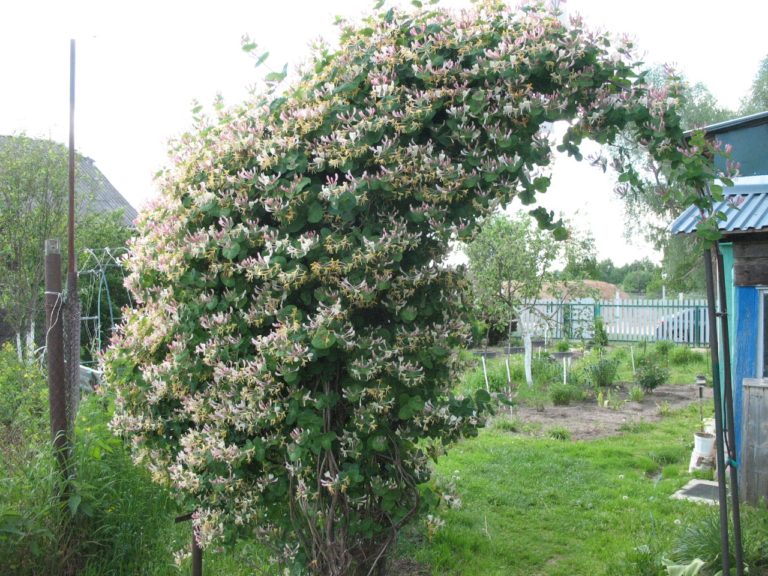
Growing conditions
Honeysuckle is a flexible plant and can grow in both full sunlight and partial shade. It prefers well-drained soil, but can tolerate a wide range of soil types as long as there is enough moisture. Regular watering is important, especially during the active growing periods in spring and summer. Although Honeysuckle is quite hardy, a soil enriched with organic matter promotes more vigorous growth and abundant flowering.
Benefits for the Pergola
Covering a pergola with Honeysuckle offers numerous benefits. Firstly, the pleasant sc ent of the flowers creates a welcoming and relaxing atmosphere, perfect for enjoying evenings outdoors. The fragrant flowers also attract birds and butterflies, promoting biodiversity and creating a lively and dynamic environment. The Honeysuckle is known for its rapid growth, capable of covering large areas in a short time, providing natural shade and privacy. In addition, its dense foliage contributes to a lush aesthetic and a more comfortable and fresh outdoor space.
Conclusion
Recap of the Five Ideal Pergola Plants
In this post, we explored five exceptional plants for covering pergolas: Jasmine (Jasminum spp.), Bougainvillea (Bougainvillea spp.), English Ivy (Hedera helix), Purple Passionflower (Passiflora spp.) and Honeysuckle (Lonicera spp.). Each of these plants brings its own unique characteristics, from the fragrant flowers of Jasmine and Honeysuckle, through the vibrant colors of Bougainvillea, to the evergreen foliage of English Ivy and the delicious fruits of Purple Passionflower.
Encouragement to Choose the Plant that Best Suits Your Environment and Needs
When choosing a plant to cover your pergola, consider the specific conditions of your space, including the amount of sunlight, the type of soil and the climate in your region. Each plant has different requirements, and selecting the right species will ensure that it thrives and provides all the desired benefits. Whether it’s to add a touch of vibrant color, attract pollinators, or simply create a shady and welcoming space, there’s an ideal plant for every need.
Invitation to Explore More About Gardening
Gardening is a rewarding activity that not only beautifies the environment, but also promotes well-being and connection with nature. We invite you to continue exploring the world of plants and discover new ways to maximize the potential of your pergola with the right plant cover. Experiment with different plant combinations, learn about their characteristics and care, and turn your pergola into a vibrant green oasis.
Frequently Asked Questions
Which flower to use on the pergola?
Choosing the ideal flower for a pergola depends on aesthetic preferences, the local climate and growing conditions. Flowers such as Jasmine, Bougainvillea and Honeysuckle are popular choices due to their vibrant colors and enchanting fragrances, creating a pleasant and inviting atmosphere.
Which vine blooms all year round?
Choosing a vine that blooms all year round can be challenging, as many of them have specific flowering periods. However, the Honeysuckle (Lonicera spp.) is an option that can offer flowers for several seasons, depending on the variety and growing conditions. Certain species of Honeysuckle are known for their prolonged flowering, bringing constant beauty to your pergola.
Which plants are suitable for pergolas?
Several plants are suitable for pergolas, providing not only aesthetic beauty, but also natural shade and a pleasant atmosphere. In addition to those mentioned above, other options include English Ivy, wisteria, St. George’s creeper and passiflora. When choosing plants for your pergola, take into account factors such as sun exposure, soil type and local climatic conditions to ensure the success of your vertical garden.
